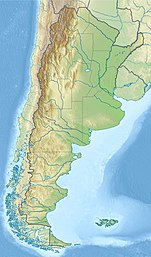| O'Higgins/San Martín Lake | |
|---|---|
 | |
 | |
| Location | O'Higgins Commune, Capitán Prat Province, Aysén del General Carlos Ibáñez del Campo Region, Chile / Lago Argentino Department, Santa Cruz Province, Argentina |
| Coordinates | 48°50′S 72°36′W / 48.833°S 72.600°W / -48.833; -72.600 |
| Primary inflows | Mayer River |
| Primary outflows | Pascua River |
| Catchment area | 12,895 km (4,979 sq mi) |
| Basin countries | Argentina, Chile |
| Surface area | 1,013 km (391 sq mi) |
| Average depth | 68 m (223 ft) |
| Max. depth | 836 m (2,743 ft) |
| Water volume | 68.88 km (16.53 cu mi) |
| Shore length | 525 km (326 mi) |
| Surface elevation | 252 m (827 ft) |
| Frozen | never |
| Sections/sub-basins | Cancha Rayada, Chacabuco, Maipú, De la Lancha |
| Shore length is not a well-defined measure. | |
The lake known as O'Higgins in Chile and San Martín in Argentina is located around coordinates 48°50′S 72°36′W / 48.833°S 72.600°W / -48.833; -72.600 in Patagonia, between the Aysén del General Carlos Ibáñez del Campo Region and the Santa Cruz Province.
General information

The lake has a surface area of 1,013 square kilometres (391 sq mi), an elevation of 250 metres (820 ft) above mean sea level, and a shoreline length of 525 kilometres (326 mi). Viewed from above, the lake consists of a series of finger-shaped flooded valleys, of which 554 square kilometres (214 sq mi) are in Chile and 459 square kilometres (177 sq mi) in Argentina, although sources differ on the precise split, presumably reflecting water level variability. The lake is the deepest in the Americas with a maximum depth of 836 metres (2,743 ft) near O'Higgins Glacier, and its characteristic milky light-blue color comes from rock flour suspended in its waters. It is mainly fed by the Mayer River and other streams, and its outlet, the Pascua River, discharges water from the lake towards the Pacific Ocean at a rate of 510 cubic metres per second (18,000 cu ft/s). The O'Higgins Glacier flows eastwards towards the lake, as does the Chico Glacier. Both of these glaciers are part of the Southern Patagonian Ice Field which extends for approximately 350 kilometres (220 mi) in a north–south direction to the west of Lake O'Higgins/San Martín.
Immigrants did not settle in the arid windy area around the lake until the 1910s, when British, Scandinavians and Swiss started raising sheep for wool.
The most common tourist route for visiting the lake is that between El Chaltén in Argentina and Villa O'Higgins in Chile, including a ferry through the lake on the Chilean side.
Water from O'Higgins/San Martín flows into the Pacific Ocean through the Pascua River.
Names
Being the most irregular of the lakes in the area, consisting of eight well defined arms, the name San Martín is sometimes used to refer only to the Argentine side, and O'Higgins only to the four Chilean arms. Both names come from independence heroes José de San Martín of Argentina and Bernardo O'Higgins of Chile, who fought together for the liberation of Chile, and came to be known as Liberators of America together with other South American figures.
The four Argentine arms of the lake, with an area of 521 km, are individually named Cancha Rayada, Chacabuco, Maipú and De la Lancha, after battles of General San Martín.
See also
References
- "Mass balance investigations at Glaciar Chico, Southern Patagonia Icefield Chile" (PDF). Archived from the original (PDF) on 2007-08-18. Retrieved 2006-10-16.
External links
- Border crossing Chaltén to O'Higgins Archived 2021-02-20 at the Wayback Machine
- CECS, Depth of Lake O'Higgins/San Martín
| Hydrography of Aysén Region | ||
|---|---|---|
| Rivers |  | |
| Lakes | ||
| Glaciers | ||